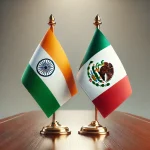Areas of Cooperation
- Political Relations
- Multilateral Cooperation: India and Latin American countries often collaborate in multilateral forums such as the United Nations, World Trade Organization (WTO), and G20. Both regions share common interests in global governance reform, climate change, and sustainable development.
- South-South Cooperation: India and Latin America are both key players in South-South cooperation, working together on issues like poverty reduction, sustainable development, and technology transfer.
- Regional Organizations: India participates in the Community of Latin American and Caribbean States (CELAC) summits and has observer status in the Union of South American Nations (UNASUR) meetings.
- Diplomatic Relations: India has embassies in key Latin American countries like Brazil, Mexico, and Argentina, working to enhance bilateral relations.
- Economic Relations
- Economic Ties: India trades with Latin America, exporting pharmaceuticals and textiles, and importing minerals and oil. For example, India imports lithium from Bolivia and exports textiles to Brazil.
- Strategic Partnerships: India collaborates with Latin American countries on energy and technology. For instance, Indian companies invest in Brazil’s energy sector and tech partnerships in Argentina.
- Investment Opportunities: Indian firms invest in Latin America, such as Tata’s investments in Brazilian steel and Mahindra’s automotive ventures in Argentina.
- Cultural Cooperation
- Cultural Exchange: There are educational and cultural exchanges. Indian dance and film festivals are held in Latin America, while Latin American art is showcased in India.
- Cultural Diplomacy: Indian culture, including Bollywood films, yoga, and traditional festivals, has gained popularity in Latin America. The Indian diaspora in countries like Trinidad and Tobago, Guyana, and Suriname also plays a role in promoting cultural ties.
- Educational Cooperation: There are growing academic exchanges and collaborations between universities in India and Latin America. Scholarships and student exchange programs are facilitating greater educational interaction.
Challenges
- Geographical Distance: The vast geographical distance between India and Latin America can pose logistical and communication challenges.
- Tariff Barriers: High tariffs and trade barriers can hinder the growth of bilateral trade.
- Infrastructure Development: Investments in infrastructure, such as transportation and logistics, are necessary to facilitate trade and investment.
Future Prospects
- Comprehensive Economic Partnership: There is potential for India to negotiate comprehensive economic partnership agreements with key Latin American countries, which could further boost trade and investment.
- Strategic Alliances: As both India and Latin America continue to rise on the global stage, there is potential for deeper strategic alliances, particularly in areas such as climate change, global governance, and sustainable development.


